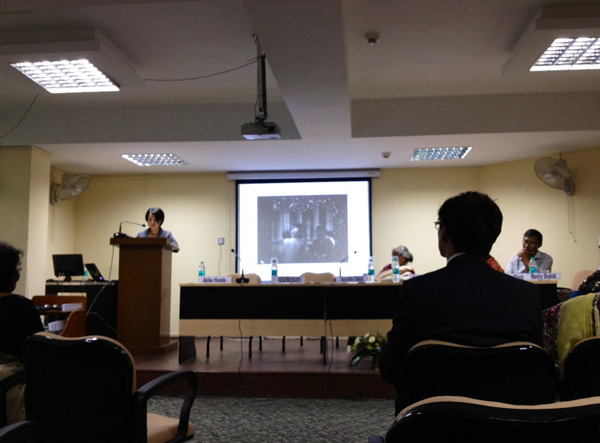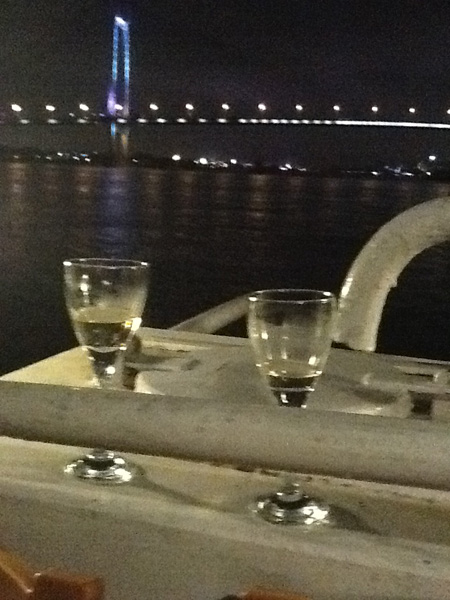

My impressions of participating in the 4th East Asian Conference on Slavic and Eurasian Studies in Kolkata
Akiko Honda
Ten or more years ago, I read David Lodge's Small World (1984), in which he satirizes academics who spend all their time traveling to conferences held all over the world. The romantic protagonist of the novel compares their travels to the pilgrimages of the medieval period: on one hand, pilgrims (i.e., researchers) atone for sins (i.e., by writing papers and listening to others' presentations); on the other hand, they enjoy foreign sights and food, and there is even the possibility of encountering a mysterious beauty. As a result, I had cultivated in my mind a fantastic image about a global academic activity that had been unrelated to me—until, that is, I had my first opportunity to participate in a real conference: the 4th East Asian Conference on Slavic and Eurasian Studies in Kolkata. Unfortunately, I found no femme (or homme) fatale there; nonetheless, the conference left me with a strong impression, on which I'd like to report briefly.
Preparation for the conference
I had badly bungled the task of drawing up an abstract. Although I had a one-month deadline for submitting the abstract, I wanted to deal with new topics, because I had just finished the protracted writing of my doctoral thesis. I submitted an abstract without having first sufficiently examined the literature or materials; therefore, while writing the draft paper following that submission, I was finding that its contents would need to diverge vastly from that set down in the abstract. I had to ask an organizer of the conference, professor Suchandana of Maulana Abul Kalam Azad Institute of Asian Studies (MAKAIAS) to change my presentation title and abstract. She listened to my request gracefully. All contact with the organizers—including this rather peculiar instance, given the circumstances—went very smoothly.
Basically, my research has focused on the shift in the center of architecture work in the first half of 20th century, from the construction site to mass media, such as photos, newspapers, magazines, and movies. These architectural images, as presented by the media, were becoming more and more influential on the public—even more so than the actual buildings. This was especially true in Soviet Russia, where many grandiose construction projects (e.g., the Palace of the Soviets) were published to great fanfare but were actually no more than plans on paper. From this viewpoint, I've been interested for some time in architecture as seen in Soviet cinema. I hypothesized that by examining that cinematic subset, we could determine the primary function of Soviet architecture—that is, as an ideological device that manifested more clearly in fabricated space (i.e., in a film) than in real space.
To test my hypothesis, I took up Grigori Aleksandrov's film The Shining Path (1940)—especially the last scene, which was shot in the real space of the site of the All-Union Agricultural Exhibition (VSKhV, now the All-Russia Exhibition Centre, VVTs), but which contains many images of architecture, including the Palace of the Soviets.
It was assumed that the specializations of the conference participants would be diverse, and that the number of those who attended and would be well versed in Soviet cinema or architecture would be very small; therefore, when I made the draft presentation, I referred to technical details as little as possible. Instead, I selected some shots from the film and analyzed them in concrete terms. I had already delivered a paper on a similar subject at the SRC summer camp in July, and so I prepared my paper with relatively little difficulty.
After I finished the paper, I rehearsed it several times in the presence of native English speakers. I obtained from them practical advice, especially on how to control the speed of my speech and thus make it easier for the audience to understand me. I cut large amounts of information from my presentation, to make it possible to reduce my delivery speed. The time allotted to each presenter was not set until the day of the conference, and so I prepared a short version of the paper, as a precaution; this shorter paper was of great assistance to me.
About the panels
I was the first presenter of the 12th panel, entitled "Culture and the Region"; it was held on the second day of the conference, September 5. This was the final panel of the entire conference, and it was devoted to media studies in Slavic and Eurasian nations. Our panel consisted of a chair, a discussant, and six presenters. (It was originally announced that there would be four panel members, but two presenters were later added to the listing.) The topics covered by our panel extended into several fields: present-day Kazakh cinema, art movements in central Asia, and coverage of the presidential elections in Kyrgyzstan, among others. Surprisingly, the discussant of our panel was the leading Indian documentary film director Gautam Ghosh. We had a relatively large audience, probably because it was the final panel of the conference. Nonetheless, I was left with the impression that my presentation hadn't successfully attracted the audience's attention. The fact that I, for time reasons, had mainly used still images (rather than video clips) might partially explain why I didn't capture the audience's attention.
In recent years, musical comedy films of the Stalin period have been the subject of lively discussion among European and North American scholars, especially from the viewpoints of gender studies and psychoanalysis. However, according to Mr. Ghosh, this has not been a popular subject in India, and so there have been very few opportunities there to watch films such as Aleksandrov's The Shining Path. Appreciative of my presentation, Mr. Ghosh said that he was interested in Eisenstein's theory, which had a great impact on Aleksandrov's work; Mr. Ghosh also emphasized the importance of reconsidering and reevaluating theory vis-à-vis early Soviet film.
Our panel concluded, having surpassed the scheduled limit by an hour or more, on account of the unexpected addition of two presenters. It was a matter of regret that we had almost no time for a Q&A session with the floor.

After the conference
With regard to the conference and how it was received, the advantages and disadvantages of being sponsored by a small and developing organization could be seen (i.e., the flexibility allowed, and the poor management system, respectively). Particularly, I felt that there was a room for improvement with regard to scheduling. For instance, at the ninth panel, entitled "Aspects of Eurasian Literature and Society," each presenter had to finish his or her presentation within 15 minutes. They read papers in a great hurry and omitted several parts therein. This was disappointing, because I had been looking forward to listening to these papers. Of course, holding an international conference is a difficult and worthy task, but I think that improving the quality of its management is now considered an important issue. I believe that more serious attention should be paid to operational methods, although I do, personally, acknowledge their considerable help.
Finally I want to add my impressions of Kolkata. The cruise on the Ganges river, on which the organizers had invited us, was an invaluable experience. So overwhelmed was I by the impact of the people and the scenery there, I almost forgot why I was in India. Also, the very tasty Bengali cuisine captivated me; I missed it during my stay in Moscow, after the conference. From what I heard from Professor Matuzato, the best way to enjoy beer in India is to buy it in a duty-free shop at the airport and bring it to a hotel. I will be sure to make use of this advice, the next time I am there.
On a personal level, I gained confidence from the valuable advice given by many people in the process of preparing my presentation. I'm certain it helped to improve my presentation skills. I'd also like to express my thanks to the professors at MAKAIAS for their assistance in creating what was ultimately a memorable experience.

Copyright ©2008-2012 Slavic Research Center | e-mail: src@slav.hokudai.ac.jp